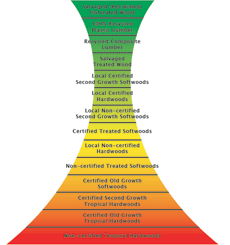
 |
 
Hierarchy of Wood Use ó Outdoor Wood
 
The figure is a graphic representation of the list. Implied in the shape is the scope of the impact, with those choices above the bottleneck generating an increasing positive impact as they move towards the top, and those below generating an increasing negative impact as they progress to the bottome. Click here to view/download a larger version of the figure. To have the least negative environmental impact, first and foremost, itís important to consider the reasons for doing the project or making the purchase in the first place. Is the project necessary and have you considered that it may have an impact on the local ecosystem as well? Assuming youíve already considered no project as the option with the least impact, of the choices listed, Rainforest Relief can only recommend options 1 and 2 from the list below. We consider options 3 Ė 5 to be very acceptable. Beyond that, material choices will have varying degress of negative impact on forest ecosystems that we canít recommend. The list is provided so you can judge the relative effects of different options. The color gradations within the image more accurately represent the "grey" nature of these choices than do the lines, since every situation is different and should be assessed on a case-by-case basis, considering perhaps dozens of different factors that can effect the relative ecological impact. 1) Untreated wood salvaged from demolished or de-constructed buildings, reclaimed railroad ties or wood otherwise removed from the waste stream; 2) recycled plastic lumber (RPL) that is 100% recycled materials and doesn't contain any wood fiber; 3) recycled plastic/wood composite lumber (this won't last nearly as long as true recycled plastic lumber and thus may give RPL a negative repuation. Composite lumber will also necessitate maintenance and replacement long before 100% plastic and will thus force one to decide on using more materials; 4) hazardous substance treated wood (HSTW) salvaged from demolished or de-constructed buildings or decks or otherwise removed from the waste stream; 5) certified domestic softwoods such as cedars, redwood, cypress and Douglas fir, logged from second growth forests or plantations; 6) certified local hardwoods (for instance, black locust, native to the U.S., is very durable, as is live oak and numerous other domestic woods. Consult the U.S. Forest Products Lab for test results on the durability of domestic woods; 7) non-certified softwoods logged from second growth domestic forests; 8) hazardous substance treated softwoods, FSC-accredited certified as originating from well-managed forest operations; 9) non-certified local hardwoods; 10) hazardous substance treated softwoods, non-certified; 11) certified softwoods logged from old growth forests; 12) certified second growth tropical hardwoods (for instance, from Central America as most of CA's forests have been logged and certifications are usually of second and third growth operations. This option supports what certification was originally meant to do: protect forest ecosystems from impending destruction); 13) certified old growth tropical hardwoods (for instance, from South America, Africa or southeast Asia, where certifications are going to almost always be old growth when it comes to woods for outdoor use); 14) non-certified tropical hardwoods. |
 |
 |
|||||||||||||||||
 Copyright 2006 Rainforest Relief |
||||||||||||||||||||
